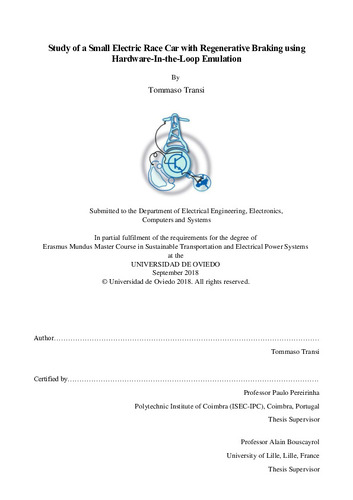Study of a Small Electric Race Car with Regenerative Braking using Hardware-In-the-Loop Emulation
Autor(es) y otros:
Director(es):
Palabra(s) clave:
Electric Vehicle
Energetic Macroscopic Representation
EV
EMR
HIL
Hardware-In-the-Loop simulation
Reduced Power HIL
Formula SAE Electric
OptimumLap
SPMSM
Regenerative braking
Fecha de publicación:
Serie:
Máster Universitario Erasmus Mundus en Transporte Sostenible y Sistemas Eléctricos de Potencia (EMMC STEPS)
Descripción física:
Resumen:
The objective of this work is to study the behaviour of an electric Formula Student car, from the Coimbra Institute of Engineering - Polytechnic of Coimbra (ISEC-IPC, Instituto Superior de Engenharia de Coimbra - Instituto Politécnico de Coimbra), Coimbra, Portugal, through a Hardware-In-the-Loop simulation, using Energetic Macroscopic Representation (EMR) graphical formalism. EMR, used to easily define a control design and tuning of the system, has been studied during a one month stay at the University of Lille, Lille, France. The corresponding EMR models were developed for software, Full Power Hardware-In-the-Loop (HIL) and Reduced Power HIL simulations. To obtain the driving cycle that the car should follow on the race track, OptimumLap© software was used. Software simulation is used to verify the validity of the model. Reduced Power Hardware-In-the-Loop simulation is implemented and verified using the experimental test bench in ISEC’s laboratory. Finally, results from software simulation and from Reduced Power HIL simulation are compared to demonstrate the validity of the two simulations.
The objective of this work is to study the behaviour of an electric Formula Student car, from the Coimbra Institute of Engineering - Polytechnic of Coimbra (ISEC-IPC, Instituto Superior de Engenharia de Coimbra - Instituto Politécnico de Coimbra), Coimbra, Portugal, through a Hardware-In-the-Loop simulation, using Energetic Macroscopic Representation (EMR) graphical formalism. EMR, used to easily define a control design and tuning of the system, has been studied during a one month stay at the University of Lille, Lille, France. The corresponding EMR models were developed for software, Full Power Hardware-In-the-Loop (HIL) and Reduced Power HIL simulations. To obtain the driving cycle that the car should follow on the race track, OptimumLap© software was used. Software simulation is used to verify the validity of the model. Reduced Power Hardware-In-the-Loop simulation is implemented and verified using the experimental test bench in ISEC’s laboratory. Finally, results from software simulation and from Reduced Power HIL simulation are compared to demonstrate the validity of the two simulations.
Colecciones
- Trabajos Fin de Máster [5283]
Ficheros en el ítem




